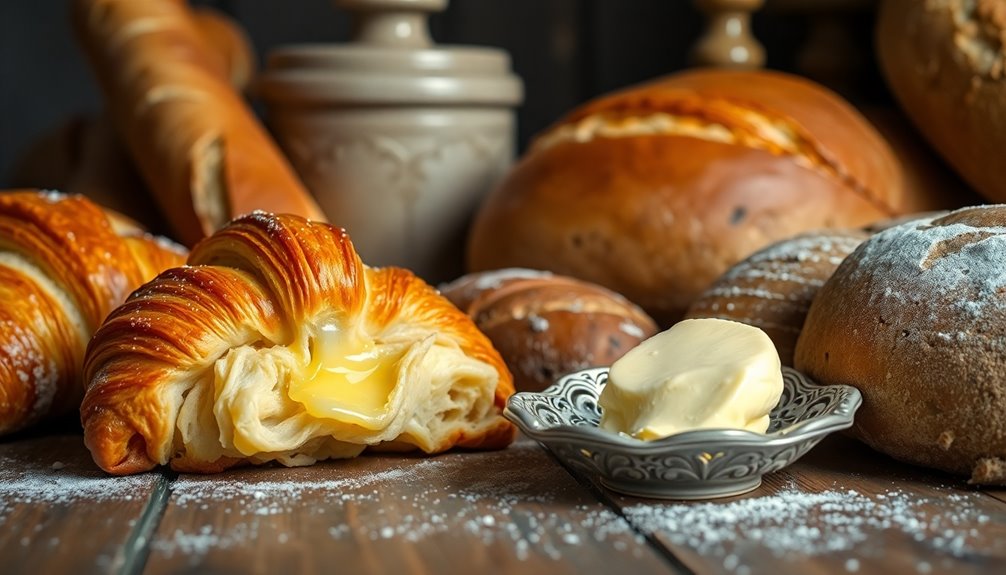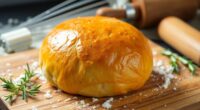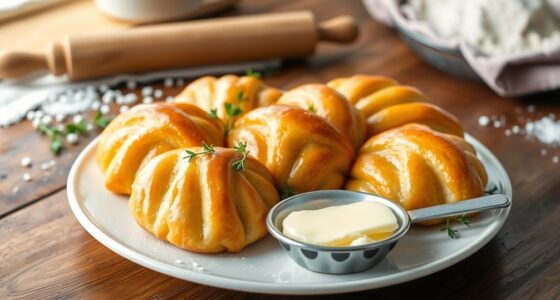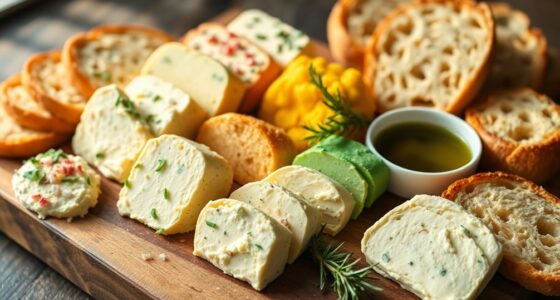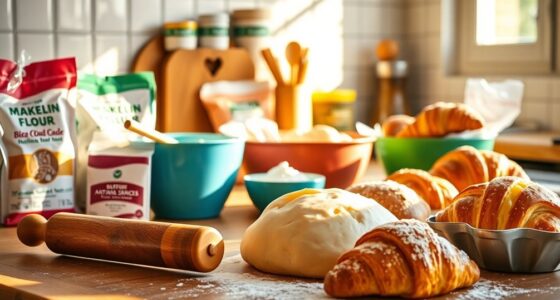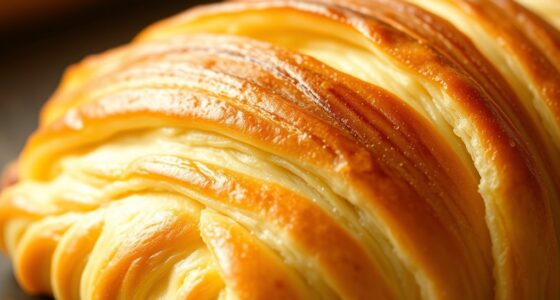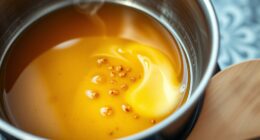Butter's revolution in bread and pastry making is undeniable. By replacing animal fats, it created tender, flaky textures in pastries and added rich flavors to baked goods. This creamy ingredient introduced innovative techniques like creaming and lamination, essential for achieving airy layers. With its historical roots in ancient cultures, butter became a symbol of elegance and luxury in cuisine. Discover how this humble ingredient has shaped classic recipes and continues to influence contemporary baking trends today.
Key Takeaways
- Butter's integration into European cuisine during the Renaissance replaced bread in some techniques, enhancing the richness of pastries and breads.
- The 19th century marked butter's emergence as a vital ingredient in French cuisine, elevating its status in pastry making.
- High-fat butter creates tender, flaky textures essential for pastries, significantly improving mouthfeel and flavor profiles.
- Innovations like laminated dough techniques and compound butter have transformed traditional pastry-making methods, creating distinct textures and flavors.
- Butter-based pastries, like croissants and brioche, showcase regional variations and highlight butter's versatility and cultural significance in global baking.
The Early Use of Butter in Baking
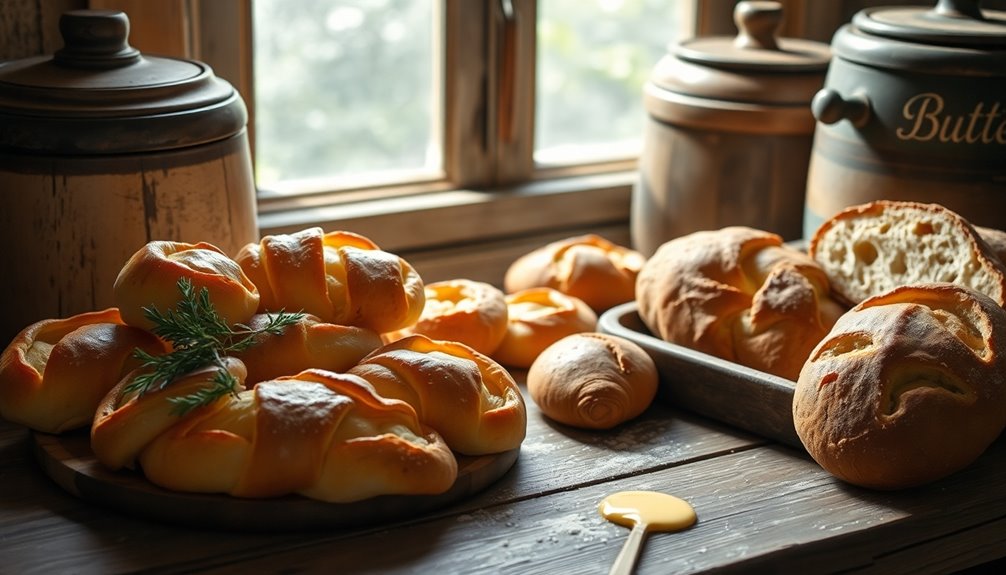
Butter has played a fascinating role in baking history, tracing its roots back to ancient cultures like Tibet, India, and China, where it was often revered in religious ceremonies.
Initially, its use in baking was limited; during the Middle Ages, butter appeared in only 2% of recipes in Taillevent's "Viandier."
However, by the 15th century, Italian cooks began to embrace butter, slowly integrating it into European culinary practices.
The Renaissance era marked a turning point, as butter replaced bread in some techniques, enriching pastries and breads. This evolution paved the way for various culinary innovations, including compound butter recipes that further enhanced flavors in dishes.
Butter's Influence on Pastry Texture and Flavor
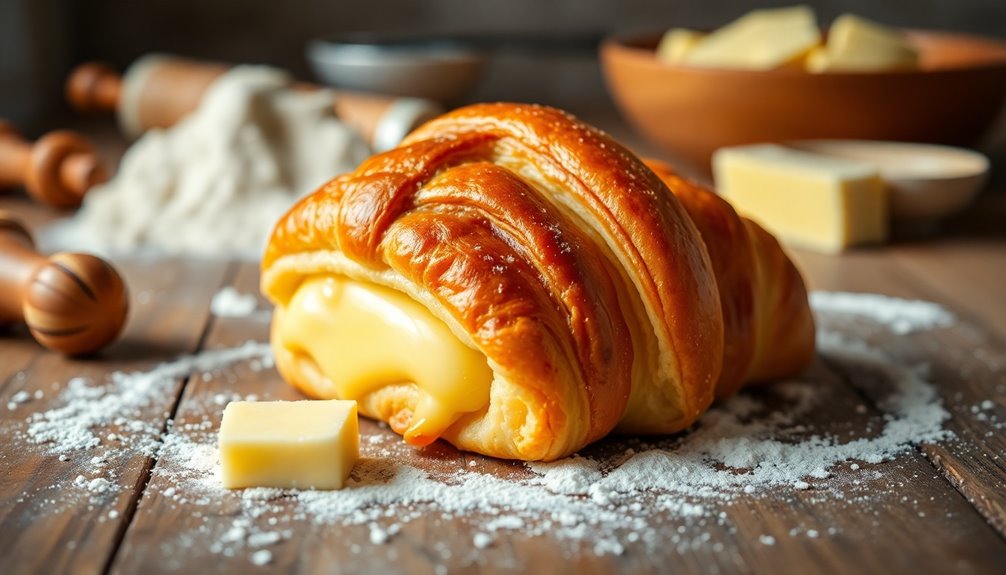
When you incorporate butter into your pastry recipes, you'll notice a remarkable enhancement in both texture and flavor. Techniques like laminating dough create those delightful layers, resulting in a light, flaky pastry that's hard to resist. Plus, the rich flavor profiles that butter brings can elevate your creations, making every bite a taste sensation. Additionally, using European butter can further amplify the creaminess and enhance the overall taste of your pastries.
Texture Enhancement Techniques
Incorporating butter into pastry dough not only enriches the flavor but also plays an essential role in achieving the desired texture. Here are some techniques to enhance your pastries:
- Use high-fat butter: Opt for butter with around 80% fat content to create a tender, flaky texture.
- Cream butter with sugar: This introduces air into your mixture, resulting in a lighter crumb in cakes and pastries.
- Layer with laminated dough: When making croissants or cruffins, the layered butter creates distinct, airy textures as steam forms during baking.
- Embrace the Maillard reaction: Baking with butter develops a golden crust, enhancing both texture and visual appeal.
Additionally, incorporating salted butter can enhance flavor and preservation, further elevating your pastry's overall taste profile.
These techniques will guarantee your pastries are irresistibly light and flaky, showcasing the transformative power of butter.
Flavor Profiles Development
While exploring the art of pastry making, you'll quickly discover how butter profoundly influences both texture and flavor. Its creamy richness enhances flavor profiles, making pastries like croissants and brioche irresistible. The shift from lard to butter during the 19th century revolutionized baking, improving mouthfeel and aroma. Additionally, the cultural significance of butter has long made it a cherished ingredient in culinary traditions around the world.
| Type of Pastry | Flavor Profile | Texture |
|---|---|---|
| Croissant | Buttery, Nutty | Flaky, Light |
| Brioche | Sweet, Rich | Soft, Tender |
| Puff Pastry | Creamy, Savory | Flaky, Airy |
| Danish Pastry | Sweet, Fruity | Layered, Crisp |
Butter's versatility allows for unique variations across cultures, enriching the pastry experience worldwide.
Role in Laminated Dough
Butter plays a pivotal role in laminated dough, where its incorporation transforms the texture and flavor of pastries. By folding chilled butter into the dough, you create distinct layers that result in a flaky, airy texture.
This process not only enhances the final product but also adds a rich flavor that makes pastries irresistible. Here are some key aspects of butter's influence in laminated dough:
- Texture: Achieves a delicate, flaky structure.
- Flavor: Provides a rich, indulgent taste.
- Crust Color: Contributes to a golden-brown finish.
- Tenderness: guarantees a soft, melt-in-your-mouth crumb.
Thanks to innovations like Claudius Gele's puff pastry, butter remains essential for perfecting modern laminated pastry recipes.
The Transition From Animal Fats to Butter
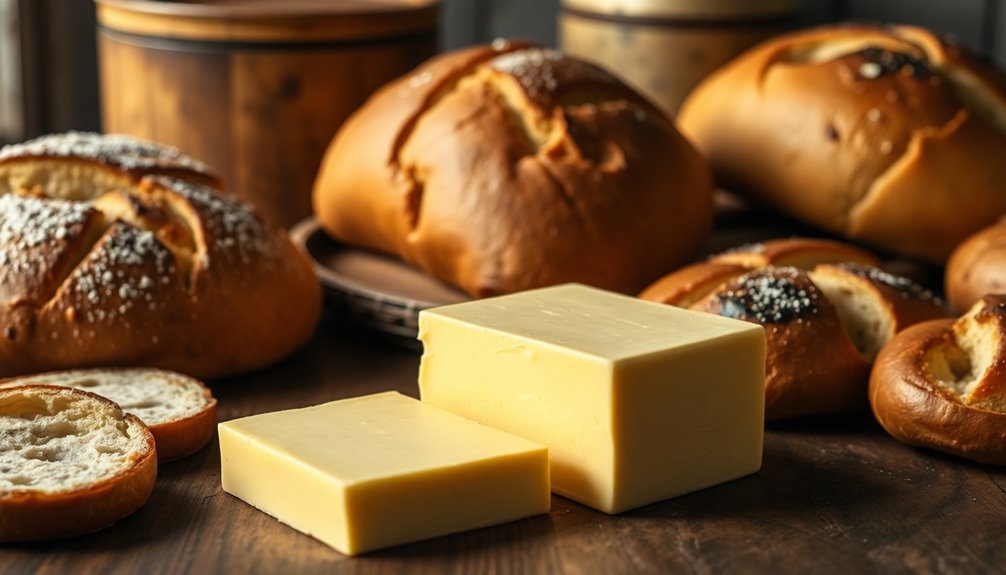
As you explore the change from animal fats to butter in baking, you'll notice how this shift reshaped culinary practices.
Butter not only introduced a richer texture but also became a symbol of sophistication in European cuisine.
Understanding this evolution reveals the significant impact it had on the quality of pastries and breads you enjoy today.
Historical Fat Preferences
In medieval Europe, cooks primarily relied on animal fats like lard and tallow for their culinary needs, yet a gradual change began to unfold as the appeal of butter emerged.
This alteration didn't happen overnight, but it marked a significant change in cooking practices.
Here are four key points about this shift:
- Flavor: Butter provided a richer taste compared to animal fats.
- Texture: It enhanced the texture of pastries and bread, making them flakier and more enjoyable.
- Culinary Evolution: By the 19th century, butter became essential in French cuisine.
- Cultural Symbolism: Butter transformed from a basic fat into a luxury ingredient, symbolizing refinement.
Additionally, butter's culinary uses in both sweet and savory dishes contributed to its rise in popularity, elevating the status of baked goods in society.
This evolution reflects not only changing tastes but also the cultural significance of butter in cooking.
Culinary Innovation With Butter
While many cooks once relied on animal fats for their culinary creations, the 19th century heralded a transformative shift as butter emerged as the star ingredient. Recognized for its flavor and versatility, butter replaced lard and oil in countless recipes, especially in French cuisine.
The late 20th century brought scientific insights into fatty acids, renewing your appreciation for butter's health benefits over previously vilified animal fats. As butter molds became popular in the 18th century, they showcased its aesthetic appeal and luxury status on aristocratic tables.
Additionally, clarified butter, or ghee, demonstrated butter's adaptability across various culinary traditions. This evolution reflects broader dietary changes, marking butter's journey from a religious ingredient to a celebrated staple in modern cooking. Furthermore, the rise of farmhouse kitchen cabinet ideas has allowed for more stylish and functional storage of butter and other essential ingredients in contemporary homes.
Impact on Pastry Texture
Butter's rise as a favored ingredient in cooking has had a profound impact on pastry texture, particularly in the change from animal fats during the 19th century.
This alteration brought about several key changes:
- Lighter, Flakier Pastries: Butter's emulsifying properties created distinct layers, enhancing texture.
- Increased Steam Production: Its higher water content contributed to steam during baking, improving rise and flakiness.
- Laminated Dough Techniques: French cuisine embraced butter, leading to the development of techniques essential for croissants.
- Clarified Butter's Rich Flavor: The use of ghee elevated pastry quality with a higher smoke point.
These innovations, influenced by figures like Marie-Antoine Carême, solidified butter's status as a cornerstone of refined French patisserie. Additionally, the shift to butter reflects a broader trend in culinary practices where high-quality ingredients are prioritized to enhance flavor and texture in cooking.
Butter in American Baking Traditions
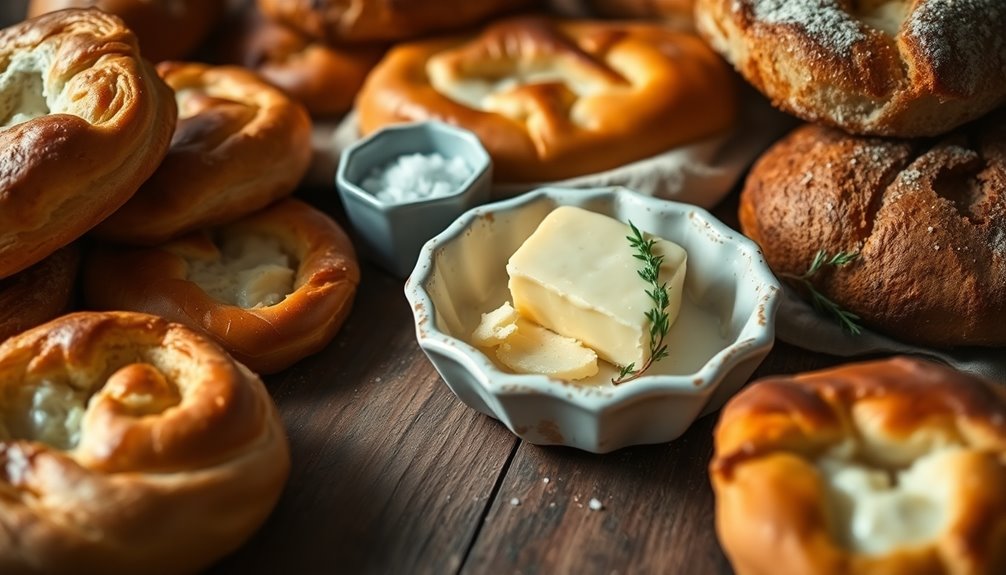
As you explore American baking traditions, you'll find that butter plays a crucial role in shaping the flavors and textures of beloved pastries.
Introduced by European settlers in the 17th and 18th centuries, butter became essential in classic recipes for biscuits, cakes, and cookies.
The 19th century saw the introduction of baking powder, which, when paired with butter, transformed American pastries into lighter, fluffier delights.
Cookbooks like Amelia Simmons' "American Cookery" popularized butter in pies and cakes, making it a staple in American kitchens.
The late 19th-century industrialization of butter production made this ingredient accessible to households nationwide.
Today, artisanal bakers continue to celebrate butter's quality and flavor, creating a diverse array of traditional and innovative pastries. Butter is a source of vitamins that enhance the nutritional profile of baked goods.
The Role of Butter in Classic Pastry Techniques
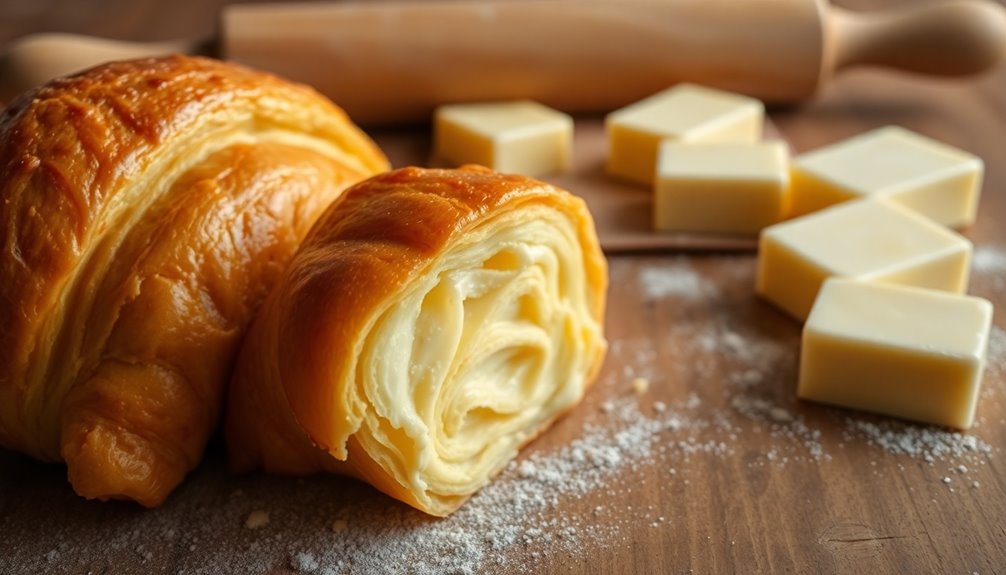
Butter isn't just a fat; it's a flavor enhancer that transforms your pastries.
When you work with laminated dough, you'll see how butter creates those signature flaky layers that make croissants and Danish pastries irresistible.
Plus, using butter in your recipes elevates the texture, giving your pastries that perfect melt-in-your-mouth quality.
Butter as Flavor Enhancer
While many ingredients contribute to the allure of pastries, the rich flavor and delicate texture that butter imparts are truly unmatched.
Butter's unique properties enhance pastries in several ways:
- Flavor Depth: It adds a creamy, rich taste that elevates any pastry.
- Tenderness: The fat from butter creates a tender crumb, essential for items like shortcrust.
- Visual Appeal: Incorporating butter with egg yolks enhances color and richness, making pastries visually enticing.
- Flakiness: When layered, butter produces flaky textures, essential for puff pastries and croissants.
Since its introduction in the 17th century, butter's role as a flavor enhancer has transformed pastries into culinary masterpieces, making it indispensable in classic and modern pastry techniques.
Techniques: Laminated Dough
Laminated dough, a cornerstone of classic pastry techniques, relies on the precise layering of dough and butter to achieve its signature flaky texture. This method involves folding and rolling the dough multiple times, creating thin layers of butter separated by dough.
As the dough bakes, steam causes these layers to expand, resulting in a light and crisp pastry. Butter's high fat content, approximately 80% in traditional varieties, is essential for richness and contributes to the unique flavor profile of pastries like croissants and puff pastry.
To master laminated dough, incorporate chilled butter and keep the dough cool during the process, preventing the butter from melting. This guarantees distinct layers, elevating your pastries to a new level of deliciousness.
Role in Pastry Texture
The role of butter in classic pastry techniques is pivotal for achieving the desired texture and flavor. When you incorporate butter, you're not just adding fat; you're creating magic in your pastries.
Here are key aspects of butter's role:
- Richness and Flavor: Butter enhances the overall taste, making pastries irresistible.
- Tender Crumb: Cold butter in puff pastry or shortcrust yields a tender texture.
- Flaky Layers: Using chilled butter during laminating generates steam that separates dough layers.
- Texture Variation: Adjusting the butter-to-flour ratio influences softness, with higher butter content creating a more delicate pastry.
Clarified butter, with its higher smoke point, can also enhance texture, showcasing butter's versatility.
Embrace butter, and your pastries will shine!
Innovations in Butter Usage Throughout History
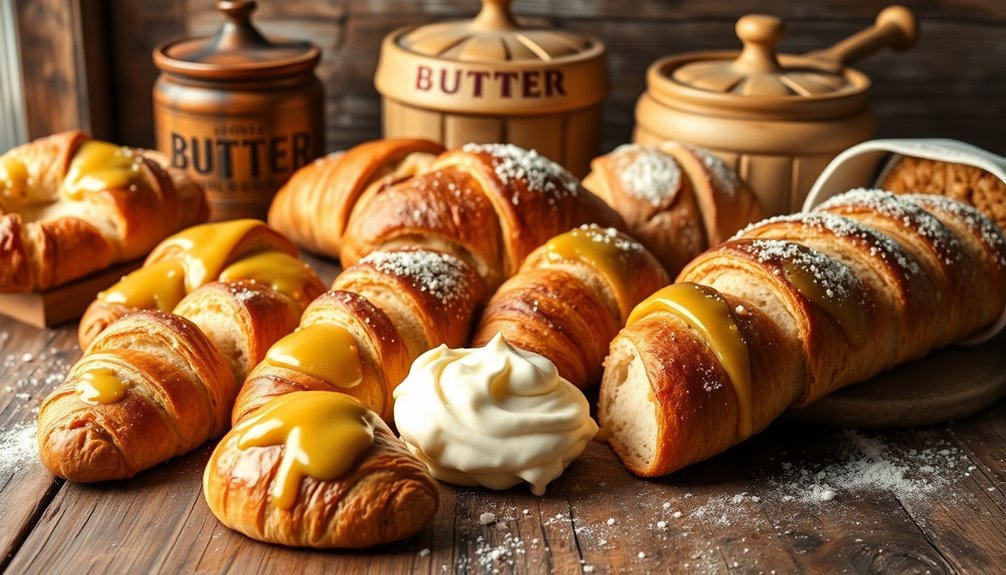
Throughout history, butter has transformed the landscape of baking and cooking, elevating both flavor and texture in a myriad of culinary creations.
During the Renaissance, its introduction into pastry making replaced animal fats, leading to richer pastries like puff pastry. Claudius Gele's invention of puff pastry in 1645 showcased butter's ability to create lighter, flaky layers, a staple in French pastry techniques.
By the 19th century, butter became the essential fat in French cuisine, replacing olive oil and animal fats, which reshaped bread and pastry recipes.
The emergence of butter molds in the 18th century not only highlighted butter's aesthetic appeal but also encouraged its use in decorative culinary presentations.
Globally, clarified butter, or ghee, demonstrated butter's versatility across cultures.
Cultural Significance of Butter in Culinary Practices
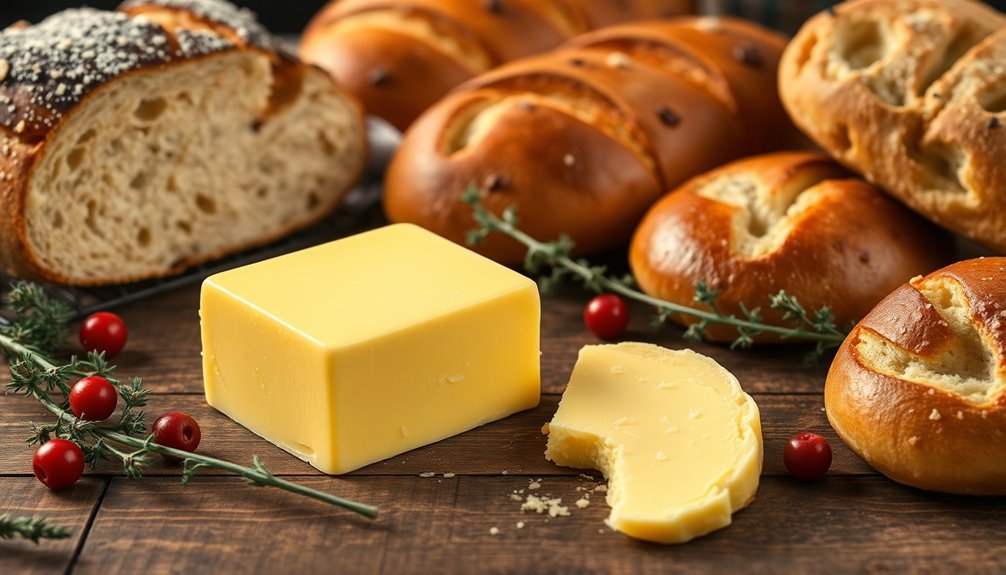
While many ingredients have shaped culinary practices over time, butter stands out for its deep cultural significance across various societies. For millennia, butter has served not just as a cooking fat but also as a symbol of refinement and luxury.
Here are some key aspects of butter's cultural importance:
- Purification Rituals: In various cultures, butter was used in traditional ceremonies.
- Health Beliefs: Northern Europeans associated butter with health benefits, enhancing its culinary status.
- Italian Integration: The 15th century saw butter become central to Italian cooking.
- French Shift: By the 19th century, butter replaced animal fats in French cuisine, marking a change to richer flavors.
Today, butter remains a staple in gourmet cooking, representing elegance and luxury in both traditional and contemporary dishes. Its nutritional composition reveals that it provides essential fatty acids and fat-soluble vitamins, further solidifying its esteemed role in culinary practices.
Health Perspectives on Butter Consumption
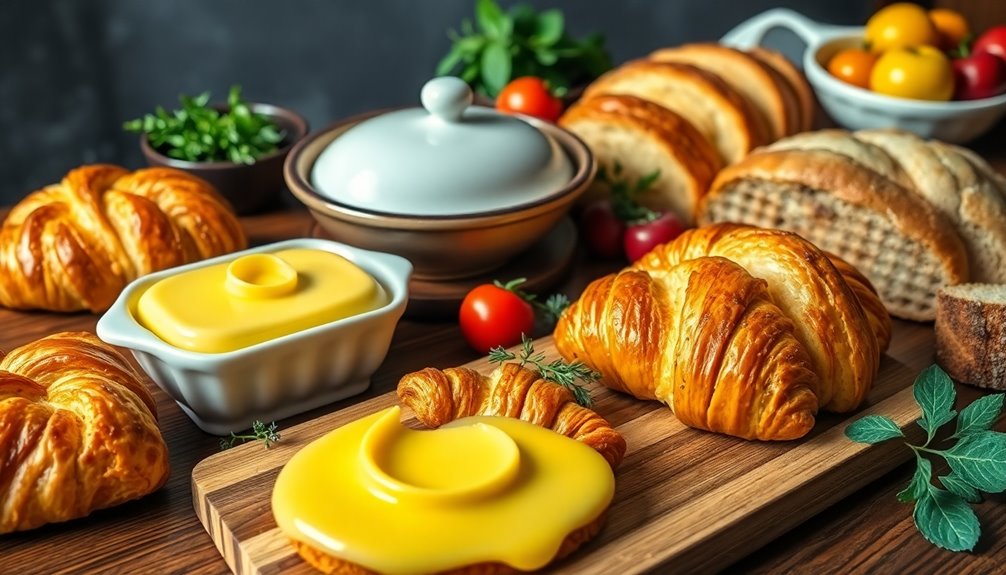
Butter's cultural prominence naturally leads to discussions about its health implications. While butter is a significant source of saturated fats that can raise LDL cholesterol levels, recent studies suggest that moderate consumption mightn't be as harmful as previously believed.
In fact, dietary guidelines have evolved to recognize that not all saturated fats impact health similarly. When sourced from grass-fed cows, butter can even provide beneficial nutrients like omega-3 fatty acids and vitamin K2, which support heart health.
Health organizations recommend balancing your butter intake with healthier fats, such as olive oil and avocados, to maintain overall wellness. So, enjoy butter in moderation while being mindful of your overall dietary patterns for better health outcomes.
Contemporary Trends in Butter and Baking
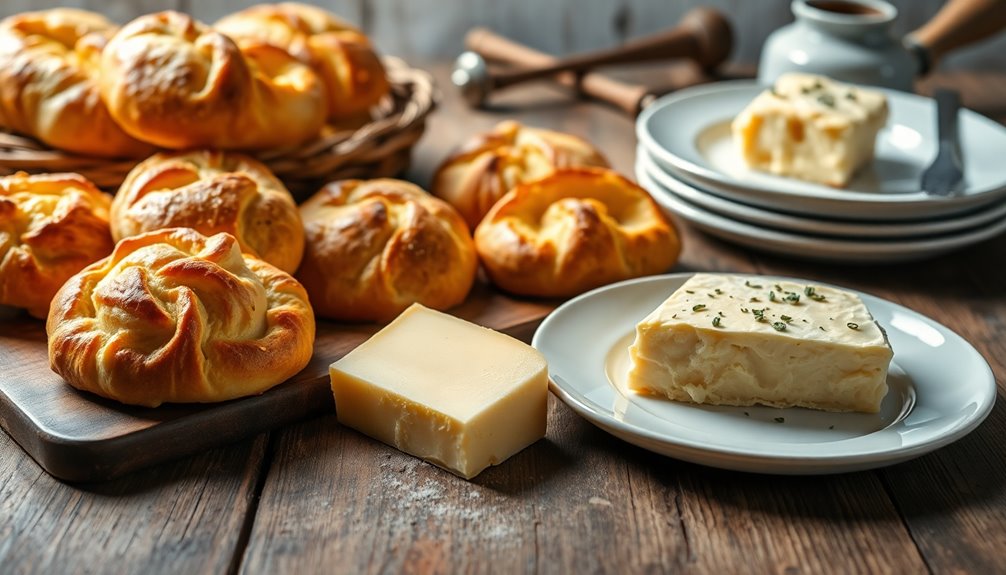
As the baking landscape evolves, many home bakers and professionals alike are turning to artisanal butters to elevate their creations. The focus on local and organic sources enhances flavor profiles in pastries and breads. Here are some contemporary trends you might want to explore:
- Artisanal Butters: Elevate flavor with high-quality, locally sourced options.
- Health-Conscious Alternatives: Experiment with plant-based butters while maintaining textures.
- Clarified Butter (Ghee): Use for a higher smoke point and richer flavor without milk solids.
- Traditional Techniques: Embrace laminated doughs, relying on premium butter for flaky textures.
These trends showcase butter's essential role in modern baking, enhancing both flavor and technique in your culinary endeavors. Additionally, the use of artistic expressions in baking highlights butter's versatility as a medium that can transform not just taste but also presentation.
Celebrated Butter-based Pastries Around the World
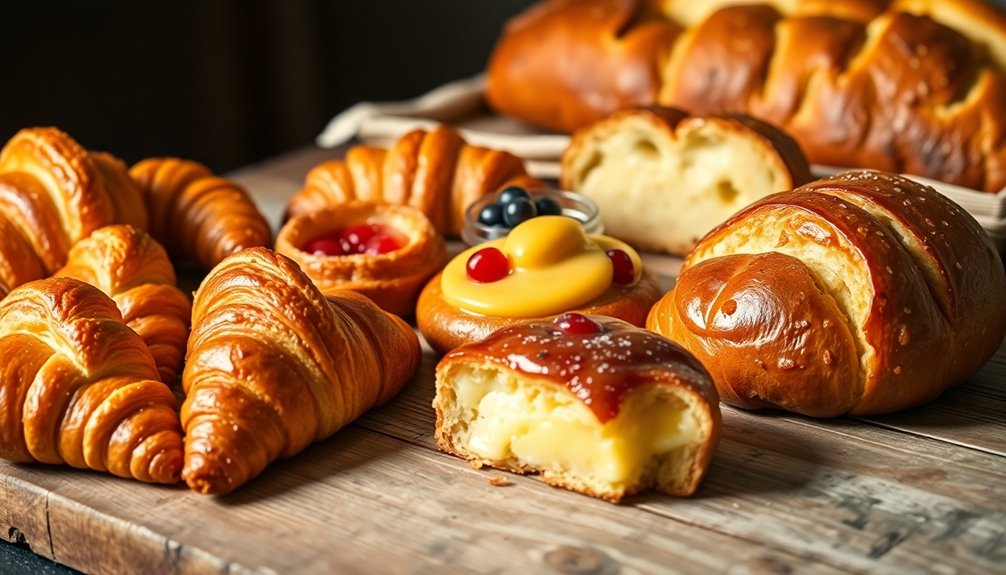
When exploring celebrated pastries around the globe, you'll quickly discover that butter plays a pivotal role in their allure and texture. From flaky croissants to rich brioche, each pastry showcases butter's magic. Here's a glimpse into some iconic butter-based pastries:
| Pastry | Description |
|---|---|
| Croissant | Flaky, buttery layers, originally from Austria. |
| Puff Pastry | Versatile dough that puffs up, perfect for mille-feuille. |
| Danish Pastry | Sweet, layered dough often filled with fruit or cream cheese. |
| Brioche | Soft, tender crumb enriched with butter and eggs. |
| Baklava | Sweet layers of filo dough brushed with butter, filled with nuts. |
These pastries not only delight the palate but also illustrate how butter elevates both flavor and texture in baking.
Frequently Asked Questions
Why Is Butter Used in Pastry Making?
Butter's essential in pastry making because it adds flakiness and tenderness to your dough.
When you use cold butter, it creates layers that make your pastries light and airy.
Its emulsifying properties bind ingredients together, resulting in a rich flavor and smooth texture.
Plus, butter's high-fat content helps achieve that beautiful golden crust you love.
What Is the History of Pastry Making?
Imagine biting into a flaky, golden pastry that tells a tale of centuries.
Pastry making has roots in ancient Egypt, where flour and oils created the first doughs. The Greeks refined this artistry with communal ovens, while the 15th-century saw luxurious ingredients like egg yolks elevate flavors.
Why Is Butter Important in Baking?
Butter's essential in baking because it enhances flavor, moisture, and tenderness.
When you use butter, you create a rich, desirable texture that elevates your pastries and breads. It also helps form a flaky structure, especially in recipes like puff pastry and croissants.
Plus, butter acts as a leavening agent when creamed, incorporating air into your batter for a light, airy rise in cakes and quick breads.
You can't underestimate its importance!
How Does Using Butter in a Baked Product Affect the Texture?
Imagine biting into a warm, flaky croissant; that's the magic of butter at work.
When you use butter in your baked goods, it creates a tender and airy texture. Its fat content keeps your treats moist while preventing excessive gluten formation, resulting in a delicate crumb.
When you cream butter with sugar, you're incorporating air, leading to a light, fluffy cake. Cold butter helps form distinct layers, ensuring your pastries are irresistibly flaky.
Conclusion
In the world of baking, butter isn't just an ingredient; it's a game-changer. Its rich flavor and unique properties have transformed bread and pastries across cultures, making them more delightful. As you explore your own baking adventures, consider how a simple slab of butter can elevate your creations. Isn't it fascinating how one ingredient can hold so much history and significance in our culinary practices? So, what will you bake next with this timeless staple?
